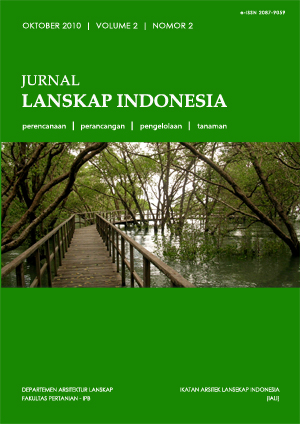SURAKARTA: PERKEMBANGAN KOTA SEBAGAI AKIBAT PENGARUH PERUBAHAN SOSIAL PADA BEKAS IBUKOTA KERAJAAN DI JAWA
Abstract
The aim of this study was to describe the relation of urban landscape development that influenced by social change. This study was focused on the changing occur before the Kingdom of Surakarta untilreformation period. The analysis was intended to find out the main factors that had been influencing the urban landscape development and also to formulate the concept of urban planning in the future based on its history and thesocial character.
Surakarta, otherwise Solo or Salay, was the capitalcity of Surakarta Hadiningrat's Kingdom. Founded in 1745, it was built on a magical rather than a rational consideration. It’s located in the crosscurrent of two rivers, the Bengawan Solo and the Pepe. According to the Javanese cosmology, the inner
city comprised of the kraton complex called Baluwarti and the alun-alun (palace square), all located inside the beteng (palace wall). Outside the palace wall were houses of the sentana (nobility), the abdi dalem (retainers) and the commonners. The coming of the Europeans, the Chinese and the Arabs formerly
did not alter the cosmology concept of the city. Inthe beginning of the twentieth century, due to the advance of technology and the expansion of business, service and leisure, the city was changed. It was in development period that the most
change towards a modern city took place. The skeleton of the city remained the same, but the environment became entirely different.
Downloads
This journal permits and encourages authors to post items submitted to the journal on personal websites or institutional repositories both prior to and after publication, while providing bibliographic details that credit, if applicable, its publication in this journal. However, after the article is submitted and published in this journal, it is fully copyrighted by the Jurnal Lanskap Indonesia or JLI. If excerpts from other copyrighted works are included, the author must obtain written permission from the copyright owner and give credit to the source in the article. Then, the writer or reader is allowed to copy, share, and redistribute articles/material in any form. But it must still include the appropriate source and credit because the article in this journal is licensed by Creative Commons Attribution 4.0 International License (CC BY 4.0).
I. Proposed Policy for Journals That Offer Open Access
Authors who publish with this journal agree to the following terms:
- Authors retain copyright and grant the journal right of first publication with the work simultaneously licensed under a Creative Commons Attribution License that allows others to share the work with an acknowledgement of the work's authorship and initial publication in this journal.
- Authors are able to enter into separate, additional contractual arrangements for the non-exclusive distribution of the journal's published version of the work (e.g., post it to an institutional repository or publish it in a book), with an acknowledgement of its initial publication in this journal.
- Authors are permitted and encouraged to post their work online (e.g., in institutional repositories or on their website) prior to and during the submission process, as it can lead to productive exchanges, as well as earlier and greater citation of published work (See The Effect of Open Access).
II. Proposed Policy for Journals That Offer Delayed Open Access
Authors who publish with this journal agree to the following terms:
- Authors retain copyright and grant the journal right of first publication, with the work after publication simultaneously licensed under a Creative Commons Attribution License that allows others to share the work with an acknowledgement of the work's authorship and initial publication in this journal.
- Authors are able to enter into separate, additional contractual arrangements for the non-exclusive distribution of the journal's published version of the work (e.g., post it to an institutional repository or publish it in a book), with an acknowledgement of its initial publication in this journal.
- Authors are permitted and encouraged to post their work online (e.g., in institutional repositories or on their website) prior to and during the submission process, as it can lead to productive exchanges, as well as earlier and greater citation of published work (See The Effect of Open Access).



























